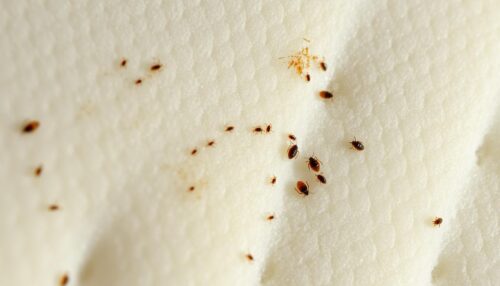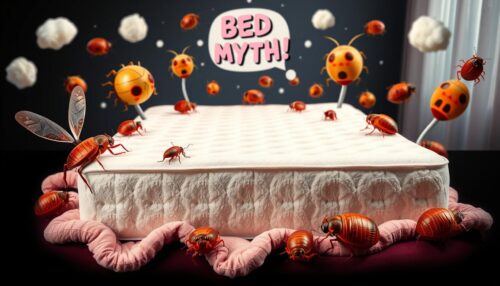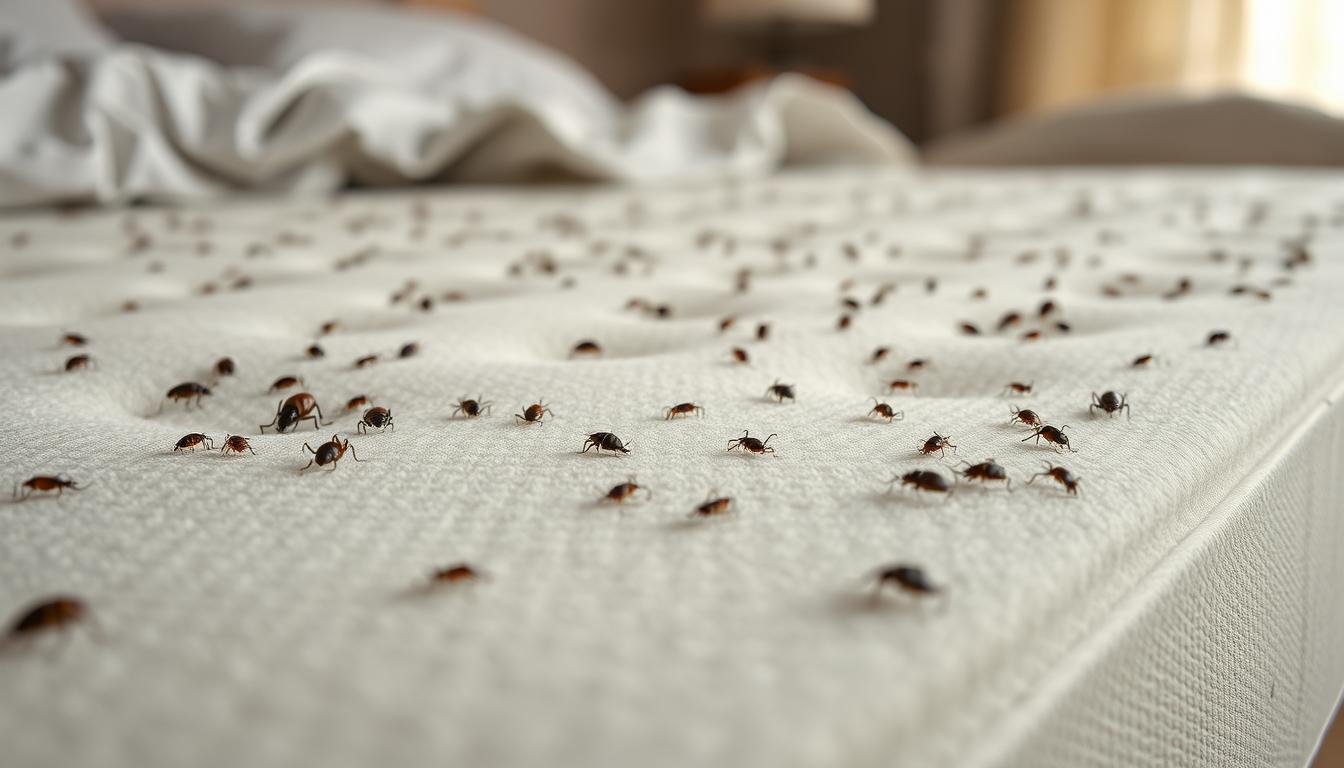Disclosure
This website is a participant in the Amazon Services LLC Associates Program, an affiliate advertising program designed to provide a means for us to earn fees by linking to Amazon.com and affiliated sites.
Are you worried about bed bugs in your memory foam mattress topper? It’s a good worry. Bed bugs can get into many types of bedding, including memory foam. Even though memory foam seems thick, bed bugs can still live there.
Bed bugs like warmth, carbon dioxide, and human blood. So, they don’t mind the material of the mattress topper. They hide in small spaces, like under the mattress, making them hard to find.
The surface and seams of the memory foam are perfect for bed bugs to hide. If you don’t stop them, they can take over your mattress topper. This makes your bed uncomfortable and not clean.
Key Takeaways
- Bed bugs can live in memory foam mattress toppers.
- The thick material of memory foam doesn’t stop bed bugs from getting in.
- It’s important to check and prevent bed bugs to keep your sleep area clean.
- To get rid of bed bugs in a memory foam topper, you need to clean, seal, and might have to replace it.
- Being careful and taking action early is key to keeping your mattress topper bed bug-free.
Understanding Bed Bugs and Their Habitat
Bed bugs are small insects that feed on human blood. They are a big problem for many homeowners. They like to hide in mattresses, bed frames, and soft furnishings. Knowing about bed bugs and where they like to hide is key to stopping them.
What Are Bed Bugs?
Bed bugs are oval-shaped and reddish-brown, about the size of an apple seed. They come out at midnight to feed on humans. Then, they hide before dawn. They don’t fly but can move fast and hide in tiny spots.
Where Do Bed Bugs Typically Live?
Bed bugs like places where people sleep, like hotels and apartments. They hide in mattress seams, bed frames, and even wall cracks. They can also ride in luggage and furniture, spreading to new places.
How Do Bed Bugs Spread?
- Bed bugs spread through furniture, bedding, and clothes moved from one place to another.
- They can also travel in luggage, backpacks, and personal items from infested places.
- Bed bugs can move between homes through walls, floors, and ceilings, making them hard to stop.
Knowing how bed bugs act is the first step to fight them. Being careful and taking action can keep them away.
Memory Foam Mattress Toppers: A Brief Overview
Memory foam mattress toppers are popular for better sleep. They are made of foam that shapes to your body. This gives great pressure relief and better sleep.
But, there are things to think about for memory foam anti bed bug and mattress topper bed bug protection.
What Is a Memory Foam Mattress Topper?
A memory foam mattress topper is a soft foam layer on top of your mattress. It makes your mattress more comfortable and supportive. The foam shapes to your body, easing pressure and helping your spine stay aligned.
Benefits of Memory Foam Toppers
Memory foam mattress toppers have many benefits:
- Pressure Relief: They spread your body weight evenly, easing pressure on your shoulders, hips, and back.
- Improved Sleep Quality: They support your body, leading to better sleep.
- Durability: They last a long time with the right care.
Common Concerns About Memory Foam Mattresses
There are some worries about memory foam mattress toppers:
- Potential for Allergens: They can hold dust mites, pet dander, and other allergens. This is a worry for people with allergies.
- Susceptibility to Bed Bugs: Memory foam is less likely to have bed bugs than other mattresses. But, it’s not completely safe. Keeping it clean and checking it often is important to avoid bed bugs.
Knowing about memory foam’s special features helps you decide. You can choose a memory foam mattress topper that’s comfy and safe.
Can Bed Bugs Thrive in Memory Foam?
Many people wonder if bed bugs can live in memory foam mattress toppers. The type of material in memory foam affects how well bed bugs can live there.
The Composition of Memory Foam
Memory foam is a thick, soft material that molds to your body. Its thick nature makes it hard for bed bugs to get inside. But, bed bugs are drawn to the warmth and carbon dioxide from people, not the foam itself.
Are Bed Bugs Attracted to Memory Foam?
Memory foam might not keep bed bugs away, but it’s not as welcoming as regular mattresses. Bed bugs can still stay on the surface, edges, and seams of memory foam toppers. But, they can’t burrow as deep as in other materials. It’s still important to check for bed bugs often and take steps to prevent them.
In short, memory foam doesn’t stop bed bugs from living on the surface of a mattress topper. But, its thick nature might make it less appealing to them. Keeping your topper clean and watching for bed bugs is crucial for a bug-free sleep area.
Signs of a Bed Bug Infestation
Bed bugs can be a big problem, even in your own bed. It’s important to know the signs of bed bugs to deal with them fast. Let’s look at the main signs to watch for.
Visual Indicators to Look For
Look for tiny, rust-colored bed bugs and their molted skins. Also, watch for black fecal spots. These signs are often found in mattress seams and other small spaces around your bed.
Bites and Skin Reactions
Bed bug bites look like itchy, red mosquito bites. Some people might not react right away, but others could get bigger rashes. If you notice any strange skin issues, it might be bed bugs.
How to Identify Bed Bug Droppings
Bed bug droppings show up as small, dark stains on your mattress or nearby. These stains are often the first sign of bed bugs.
Checking your bedding and mattress seams often is key to catching bed bugs early. Being careful can stop the problem from getting worse. It also makes your memory foam mattress topper a safer place to sleep.

Prevention Tips for Memory Foam Toppers
To keep your memory foam mattress topper bed bug-free, act early. Clean often and check for bugs to avoid infestations and sleep well.
Regular Cleaning and Maintenance
Wash your bedding in hot water (above 40°C) to kill bed bugs and their eggs. Vacuum your topper often. Use safe cleaners to keep it fresh and bug-free.
Encasing Your Mattress Topper
Get a bed bug-proof cover for your topper. These covers trap bed bugs inside, stopping them from getting in or out.
How to Properly Store Memory Foam
Store your topper in airtight bags or containers when not in use. This keeps bed bugs out, stopping infestations during storage.
Follow these tips to protect your memory foam topper from bed bugs. Keep your sleep area comfortable and bug-free.
Treatment Options for Bed Bug Infestations
If you think your memory foam mattress topper has bed bugs, act fast. There are many ways to get rid of them, both on your own and with professional help.
DIY Bed Bug Removal Methods
For small infestations, you can try some DIY methods. First, wash any items that might be infested in hot water (at least 140°F/60°C). Then, dry them on high heat. Next, vacuum your mattress topper well, focusing on seams and crevices where bed bugs hide.
You can also use EPA-approved insecticides on the affected areas. But, make sure to read and follow the instructions carefully.
When to Call a Professional
If the infestation is bad or doesn’t go away, call a professional pest control service. They have the right tools and know-how to get rid of bed bugs from your mattress topper. They might use heat treatments, raising the temperature to 140°F or more to kill bed bugs and their eggs.
This method is often better than using pesticides for serious infestations.
Importance of Follow-Up Treatments
It doesn’t matter if you treat the bed bugs yourself or get professional help. You’ll need to do follow-up treatments to make sure they’re all gone. Bed bugs can be very hard to get rid of, so keep watching and treating the areas until the problem is solved.
By being proactive and, if needed, getting professional help, you can get rid of bed bugs on your memory foam mattress topper. This will help you get back your peace of mind.
How to Check Your Memory Foam for Bed Bugs
Checking your memory foam mattress topper for bed bugs is very important. It helps keep your sleep area healthy and free from pests. By regularly checking your bedding, you can spot any bed bug problems early. This way, you can take action to get rid of them.
Steps to Inspect Your Mattress Topper
- First, take off everything from your bed, including sheets and the memory foam topper.
- Then, shine a bright light on the topper’s surface. Look closely at seams, folds, and edges.
- Search for signs of bed bugs like tiny rust-colored bugs, eggs, or dark spots (their poop).
- Use a credit card edge to gently check seams and folds for hidden bugs.
Areas to Focus On During Inspection
When inspecting your memory foam for bed bugs, watch these spots closely:
- Look at the corners and edges of the topper. Bed bugs like to hide in these spots.
- Check seams and folds. Bed bugs often gather here and lay eggs.
- Don’t forget the underside of the topper. Bed bugs can also live here.
Regular checks are crucial to catch bed bug problems early. By inspecting your memory foam mattress topper regularly, you can keep your sleep area comfortable and bug-free.
Myths About Bed Bugs and Mattress Toppers
There are many wrong ideas about bed bugs and memory foam mattress toppers. Some think bed bugs can’t live in memory foam. Others believe they only infest dirty homes. But the real story is different.
Common Misconceptions
- Bed bugs can’t live in memory foam mattress toppers: This is a common myth, but it’s simply not true. Bed bugs can thrive in any type of mattress or topper, regardless of the material.
- Bed bugs only infest dirty homes: Another misconception is that bed bugs are a sign of poor cleanliness. In reality, bed bugs can be found in the cleanest of homes, as they don’t discriminate based on hygiene.
- Bed bugs transmit diseases: While bed bug bites can cause discomfort and skin irritation, these pests are not known to spread any diseases. Their bites are mainly a nuisance rather than a health hazard.
Facts vs. Fiction
It’s important to know the truth about bed bugs and memory foam mattress toppers. Bed bugs can live in any sleeping environment, clean or not. Plus, their bites are more of a bother than a health risk. Learning the facts helps protect your home and family from these pests.

The Role of Heat in Bed Bug Control
Getting rid of bed bugs can be tough. But, using heat is a great way to fight them. Heat over 118°F (48°C) kills bed bugs and their eggs. This makes heat a strong ally in the battle against these pests.
When treating memory foam mattress toppers, heat plays a big role. It’s important to understand how heat works.
How Heat Affects Bed Bugs
Bed bugs are tough, but heat is too much for them. Temperatures over 118°F (48°C) can kill them fast. Professional heat treatments can go up to 140°F (60°C). This ensures all bed bugs are gone.
Using Heat to Treat Memory Foam Toppers
Dealing with bed bugs in memory foam toppers needs care. Always follow the maker’s advice to avoid damage. DIY methods like a clothes dryer on high can work for small items. But, for big infestations, professional help is best.
Professional services can treat the whole topper. This gives a complete solution to get rid of bed bugs.
Getting ready for heat treatments is important. Make sure there’s good air flow and no blocks. This helps the heat reach every part of the topper. It makes sure bed bugs have nowhere to hide.
Heat treatments can make your memory foam topper bed bug-free again. You can use professional services or DIY methods. Both ways, heat is a good way to get rid of bed and sleep well again.
Conclusion: Should You Worry About Bed Bugs?
Final Thoughts on Prevention
Bed bugs can live in memory foam mattress toppers, but you can fight them. Use mattress encasements and keep things clean. Also, watch out for bed bugs when you travel.
Embracing Peace of Mind with Your Mattress Topper
Bed bugs are common and don’t mean you’re dirty. You can still enjoy your memory foam topper. Stay informed, prevent bed bugs, and fix problems fast.
Bed bugs are a problem, but they shouldn’t ruin your sleep. With effort and the right steps, you can keep your sleep space safe. Enjoy a good night’s sleep without bed bug worries.

